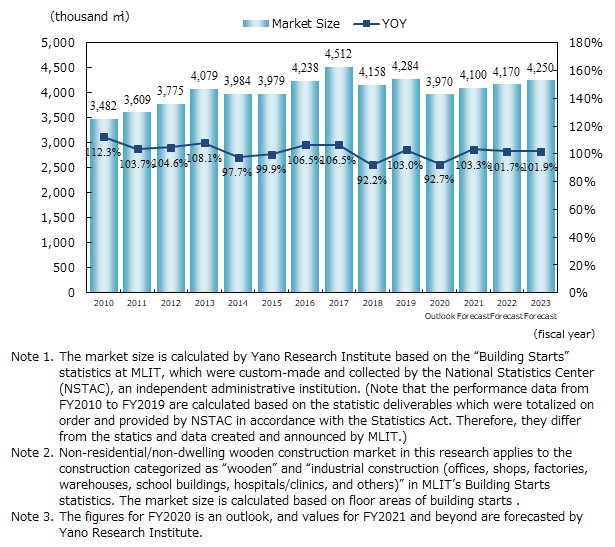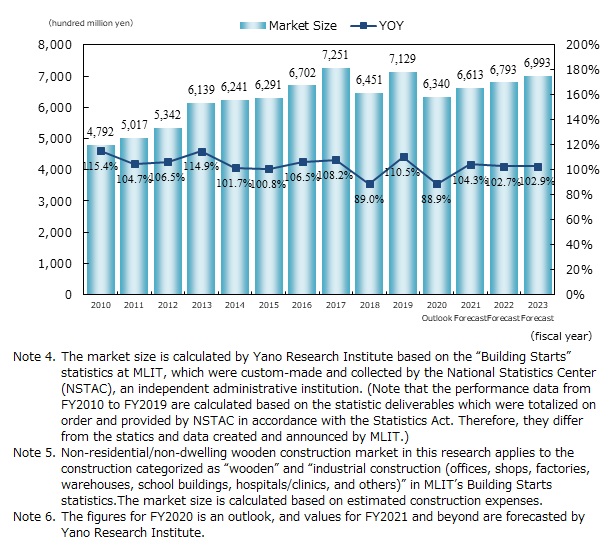No.2669
Non-Residential/Non-Dwelling Wooden Construction Market in Japan: Key Research Findings 2020
Non-Residential Wooden Construction Market for FY2019 Rose by 10.5%, Generated 712,900 Million Yen
Yano Research Institute (the President, Takashi Mizukoshi) has conducted a survey on the domestic non-residential (non-dwelling) wooden construction market and has found out the market size, the trend by segment, and the future outlook.


Market Overview
The domestic market of non-residential wooden construction (new constructions and addition/renovation) for FY2019 by floor area increased to 4,284,000 square meters (103.0% of the size of preceding fiscal year), and the market size by estimated construction expenses rose to 712,900 million yen (110.5% of the size of previous fiscal year).
The market growth by floor area was sluggish because of an expansion of floor area per project. By application, major non-residential wooden constructions include welfare facilities for elderly, childcare facilities (kindergartens/nurseries), offices and shops, while it is also expanding to warehouses, commercial facilities, and hotels. Demand is shifting toward wooden construction for rebuilding of lumber companies’ head office building and other office buildings which used to be RC construction (reinforced concrete construction). It is assumed that the increase of non-residential wooden construction for large-scale facilities (larger than 3,000 square meters) also contributed to the market growth.
By estimated construction expenses since FY2010, size of the market for FY2019 was the second-largest after FY2017. Behind this expansion is a rise of large scale properties using fire-retardant-treated wood members for interior decoration and an uptick of price per construction project due to soaring labor cost. While the spread of COVID-19 caused suspension or cancellation of some projects and postponement of construction starts scheduled in year-end of FY2019 (after February 2020), the impact seems to have been minimal for the entire market.
Noteworthy Topics
Growing Momentum towards Wooden Construction to Realize a “Decarbonized Society”
From a perspective that the use of wood contributes to achievement of United Nations Sustainable Development Goals (SDGs), cooperation for use of lumber is in progress across industries, not just among lumber and construction industries. The SDGs is adding momentum to demand expansion for lumber.
Cross-industry initiative* in trying to increase use of wood is expanding. For example, joint platform of industry, academia, and financial sector called Wood Solution Network started; “Shin-rin-riyo Suishin Zenkoku Kaigi (National Conference Promoting Use of Lumber)” is established with 44 regional associations of Japan Association of Corporate Executives, 42 governors, and 48 mayors who participate in “CLT-zai-de Chiho-Sousei-wo Jitsugen-suru Shucho Rengo (Alliance of Leaders for Regional Revival with Use of Cross Laminated Timber)”; “Shinrin-wo-Ikasu Toshi-no Mokuzoka Suishin Kyogikai (Council Promoting Utilization of Forest and Woods for Wooden Metropolis)” is convened by enterprises and associations of forestry, lumber, and construction industries; a working team for introduction of wooden structure and wooden interior decoration is organized within the Construction Committee of Japan Federation of Construction Contractors; and Forestry Agency of MAFF coordinated “Roadmap for Use of Lumber for Large-scale Construction”.
The“Shinrin-wo-Ikasu Toshi-no Mokuzoka Suishin Kyogikai (Council Promoting Utilization of Forest and Woods for Wooden Metropolis)” announced a policy to extend the application of the “Act for Promotion of Use of Wood in Public Buildings” to private constructions. As a lawmaker-initiated legislation is expected to be enacted in 2021 for revising the Act to include private constructions, expanding trend of non-residential wooden construction market is noteworthy.
*Note that the initiatives mentioned in quotation marks have no official English names. The names in English above are tentative translations by Yano Research Institute.
Future Outlook
Size of the domestic non-residential construction market for FY2020 is projected to reach 3,970 thousand square meters by floor area (92.7% of the previous fiscal year), and 634,000 million yen by estimated construction expenses (88.9% of the preceding fiscal year).
In FY2020, declaration of the state of emergency due to spread of COVID-19 influenced starts of small-scale, short work period constructions because of restricted business operations, while some constructions of eating and drinking facilities were cancelled or postponed due to the calamity. Furthermore, against the background of economic uncertainties, a trend of manufacturing industry cutting back in capital investments was seen. It is assumed that the curtailment affected the construction starts of manufacturing plants including those in wooden structure.
The non-residential construction market is deeply impacted by the trends in construction starts of large-scale buildings (an area larger than 3,000 square meters). A small percent of increase in the market size is anticipated temporarily for FY2021, owing to demand carryovers, which refers to the construction starts of large-scale projects that were postponed in FY2020 due to COVID-19.
Assuming that the market transition remain at same level, the market for FY2021 is forecasted to attain 4,250 thousand square meters by floor area (99.2% of that of FY2019), and 699,300 million yen by estimated construction expenses (98.1% of that of FY2019).
Research Outline
2.Research Object: Construction businesses of non-residential wooden buildings (general constructors, house makers, laminated wood makers, structural material (pre-cut) makers, architectural hardware makers, etc.)
3.Research Methogology: Face-to-face interviews by our specialized researchers, survey via telephone/email, collection and analysis of literature and public information. * The market size is calculated by Yano Research Institute based on the “Building Starts” statistics at MLIT, which were custom-made and collected by the National Statistics Center (NSTAC), an independent administrative institution. Note that the performance data from FY2010 to FY2019 are calculated based on the statistic deliverables which were totalized on order and provided by NSTAC in accordance with the Statistics Act. Therefore, they differ from the statics and data created and announced by MLIT.
What is the Non-Residential Wooden Construction Market?
Non-residential wooden construction in this research applies to the construction categorized as “industrial construction (offices, shops, factories, warehouses, school buildings, hospitals/clinics, and others)” and “wooden” in MLIT’s Building Starts statistics. The market size is calculated based on floor areas of building starts and estimated construction expenses. In addition to new constructions, those for addition and renovation are included.
While “medium to large scale wooden construction (medium to high rise wooden building)”, which is similar to non-residential wooden construction, includes houses such as apartment houses, those are excluded from the calculation of the market size.
<Products and Services in the Market>
Non-residential/non-dwelling wooden construction
Published Report
Contact Us
The copyright and all other rights pertaining to this report belong to Yano Research Institute.
Please contact our PR team when quoting the report contents for the purpose other than media coverage.
Depending on the purpose of using our report, we may ask you to present your sentences for confirmation beforehand.